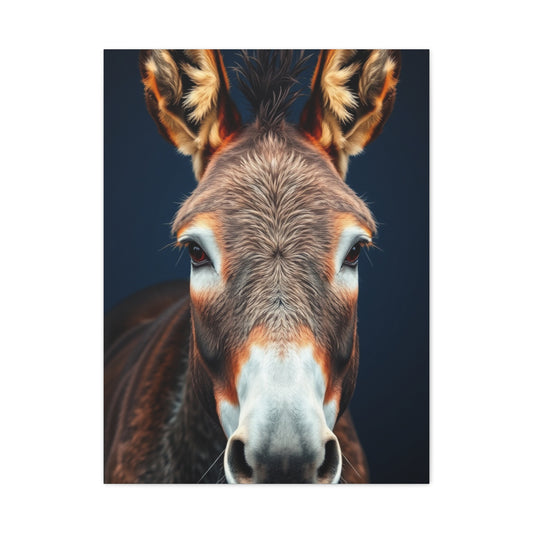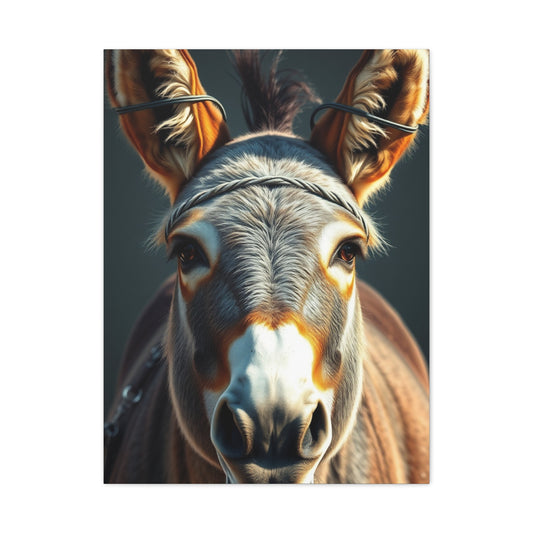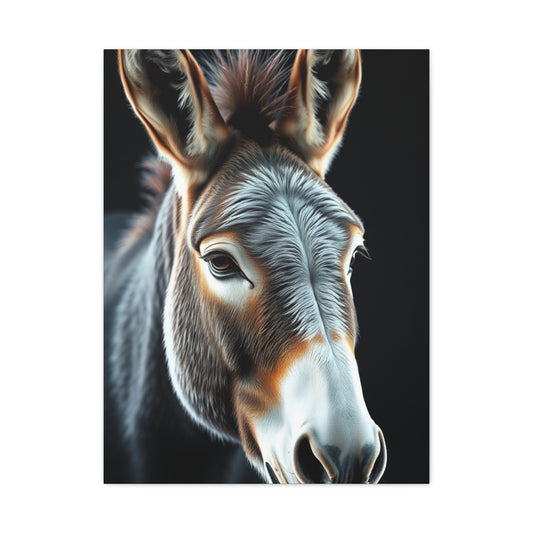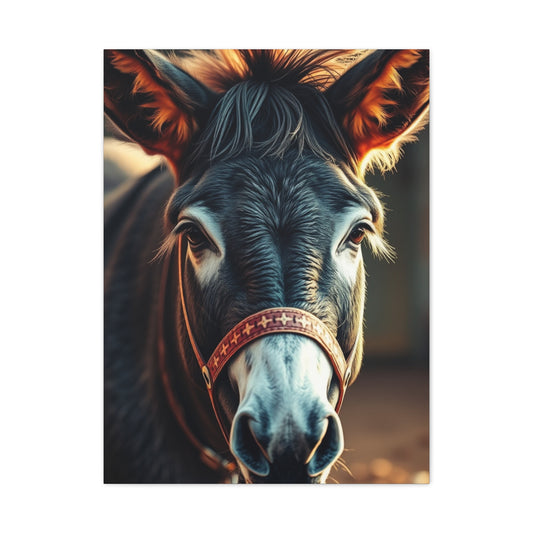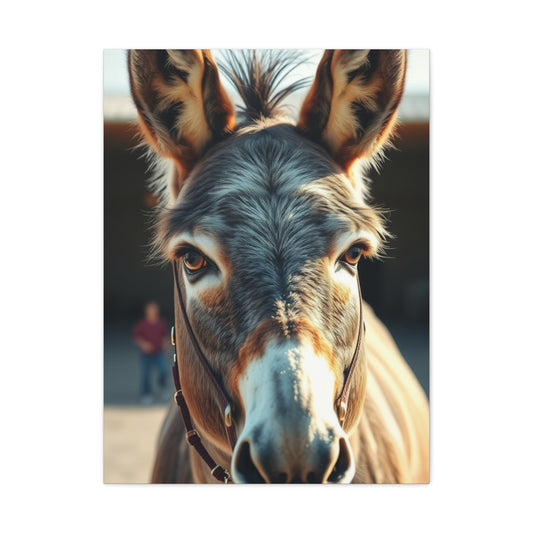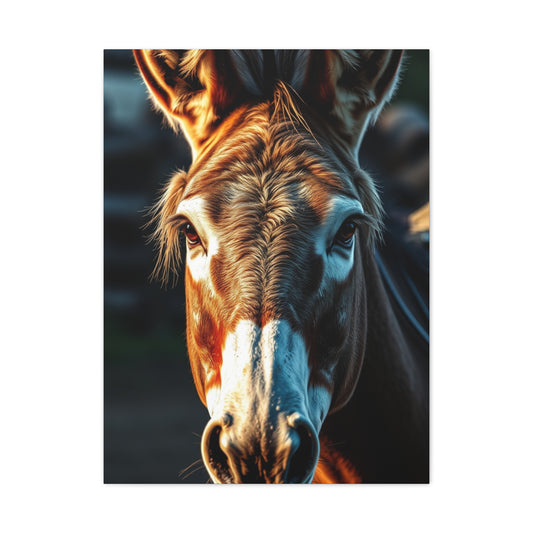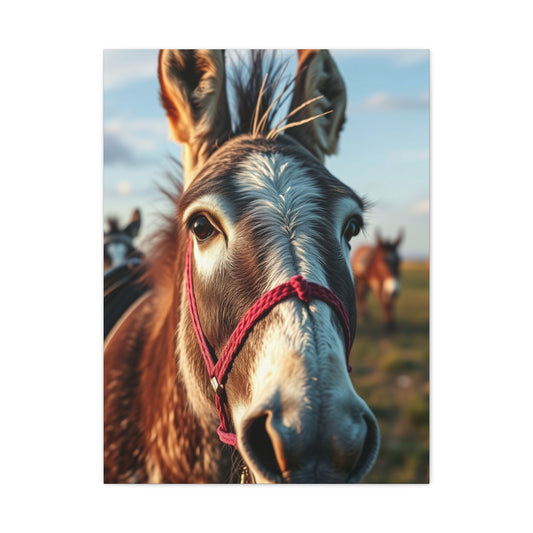Discovering the Enchanting World of Donkey-Themed Wall Art work
The contemporary interior design landscape has witnessed an extraordinary surge in the popularity of animal-themed wall decorations, with donkey artwork emerging as a particularly captivating choice for homeowners seeking to infuse their living spaces with rustic charm and whimsical appeal. These endearing creatures, once primarily associated with pastoral farmlands and rural environments, have transcended their traditional boundaries to become sophisticated elements of modern home décor.
Donkey wall prints represent far more than mere decorative accents; they embody a profound connection to simpler times, agricultural heritage, and the inherent beauty found in everyday farm life. The artistic representation of these gentle beasts captures their distinctive characteristics - those soulful eyes, expressive ears, and humble demeanor - transforming them into compelling focal points that resonate with viewers on multiple emotional levels.
Contemporary artists and photographers have embraced donkeys as subjects worthy of artistic interpretation, creating diverse collections that range from photorealistic portraits to abstract interpretations. This artistic evolution has elevated donkey imagery from simple farm animal depictions to sophisticated wall art that complements various interior design styles, from traditional farmhouse aesthetics to modern minimalist environments.
The versatility of donkey-themed artwork extends beyond stylistic boundaries, offering homeowners numerous opportunities to incorporate these charming pieces into their decorative schemes. Whether displayed as standalone statement pieces or integrated into gallery walls alongside complementary artwork, donkey prints possess the remarkable ability to anchor a room's visual narrative while adding layers of personality and warmth.
Exploring Rustic Donkey Artwork Collections and Their Aesthetic Appeal
Rustic donkey art encompasses a broad spectrum of artistic expressions that celebrate the authentic, unpolished beauty inherent in country living. These pieces typically feature weathered textures, earthy color palettes, and compositional elements that evoke memories of barnyard scenes, pastoral landscapes, and the timeless rhythm of agricultural life. The rustic aesthetic deliberately embraces imperfections, distressed finishes, and organic irregularities that speak to the handcrafted traditions of rural artisanship.
Artists specializing in rustic donkey artwork often employ techniques that simulate aged surfaces, incorporating elements such as distressed wood backgrounds, vintage-inspired typography, and sepia-toned coloring that suggests historical provenance. These artistic choices create visual narratives that transport viewers to bygone eras when life moved at a gentler pace and human connections to animals were more intimate and immediate.
The appeal of rustic donkey art extends beyond mere nostalgia, tapping into contemporary desires for authenticity in an increasingly digital world. Homeowners gravitate toward these pieces because they represent genuine emotions, honest simplicity, and the enduring values associated with rural life. The donkey, as a subject, perfectly embodies these qualities through its reputation for steadfast loyalty, hardworking nature, and unpretentious demeanor.
Color schemes in rustic donkey artwork typically draw from natural earth tones - warm browns, muted grays, soft creams, and weathered blues - creating harmonious compositions that integrate seamlessly with farmhouse and country-style interiors. These palettes possess an inherent versatility that allows them to complement existing décor without overwhelming other design elements, making them ideal choices for homeowners seeking to enhance their spaces without complete renovations.
The textural qualities of rustic donkey art often incorporate mixed media elements, combining traditional painting techniques with photographic elements, fabric applications, or dimensional accents that add tactile interest to wall displays. These layered approaches create depth and visual complexity that rewards closer inspection while maintaining broad appeal from viewing distances.
Canvas-Based Donkey Décor Options for Modern Interior Spaces
Canvas prints have revolutionized the accessibility and versatility of donkey-themed wall décor, offering homeowners museum-quality reproductions that capture every nuance of the original artwork. The canvas medium provides several distinct advantages over traditional paper prints, including superior durability, enhanced color saturation, and the ability to display large-format images without framing requirements.
High-quality canvas donkey prints utilize advanced printing technologies that reproduce fine artistic details with remarkable fidelity, preserving the subtle gradations, textural elements, and color relationships that define exceptional artwork. The fabric surface of canvas naturally diffuses light, eliminating glare issues common with glossy print surfaces while creating a professional gallery appearance that elevates any interior space.
The sizing flexibility of canvas prints makes them particularly suitable for diverse architectural environments. Large-format donkey canvases can serve as dramatic focal points in spacious living rooms or dining areas, while smaller pieces work beautifully in intimate settings such as bedrooms, bathrooms, or hallway galleries. This scalability ensures that donkey canvas décor can adapt to virtually any spatial constraint while maintaining visual impact.
Contemporary canvas printing techniques also enable the creation of multi-panel compositions, where single donkey images are divided across multiple canvases to create dynamic wall installations. These triptych or diptych arrangements add architectural interest to blank walls while allowing for creative spacing and positioning that can complement existing furniture arrangements or architectural features.
The frameless presentation characteristic of canvas prints contributes to their modern appeal, creating clean lines and uninterrupted visual flow that aligns with contemporary design preferences. Gallery-wrapped canvases, where the image extends around the edges of the frame, eliminate the need for traditional matting and framing while providing a sophisticated, finished appearance suitable for any décor style.
Donkey Wall Decorations and Country Living Aesthetics
Farmhouse interior design has experienced unprecedented popularity in recent years, with donkey wall art serving as perfect ambassadors for this beloved aesthetic movement. The farmhouse style celebrates the honest simplicity of rural life, emphasizing natural materials, vintage-inspired elements, and the comfortable functionality that defined traditional agricultural homes.
Donkey artwork naturally aligns with farmhouse design principles through its connection to pastoral life and agricultural traditions. These pieces often feature compositional elements that reflect farmhouse values - wide open spaces, natural lighting, and the peaceful coexistence of humans and animals that characterized rural homesteads. The inherent humility and practicality of donkeys mirror the farmhouse philosophy of valuing substance over superficial ornamentation.
Color coordination plays a crucial role in integrating donkey wall art into farmhouse décor schemes. Traditional farmhouse palettes favor neutral tones - whites, creams, soft grays, and warm wood tones - that create serene, uncluttered environments. Donkey artwork that incorporates these colors seamlessly integrates with existing décor while adding visual interest through subject matter rather than competing color statements.
The scale and positioning of farmhouse donkey art should reflect the generous proportions and casual elegance characteristic of this design style. Large-scale pieces work particularly well in farmhouse interiors, where high ceilings and open floor plans can accommodate substantial artwork without overwhelming the space. Grouping smaller donkey prints in casual arrangements also reflects the collected-over-time aesthetic that defines authentic farmhouse style.
Complementary decorative elements can enhance the impact of farmhouse donkey art while reinforcing the overall design theme. Vintage wooden frames, galvanized metal accents, mason jar lighting fixtures, and reclaimed wood shelving create cohesive environments where donkey artwork feels naturally integrated rather than arbitrarily placed. These supporting elements should maintain the casual, unpretentious character that makes farmhouse design so appealing to contemporary homeowners.
Portrait-Style Donkey Prints and Their Emotional Resonance
Portrait-style donkey prints represent perhaps the most emotionally engaging category of donkey wall art, focusing intently on the individual character and personality of these remarkable animals. Unlike landscape or scene-based compositions, portrait prints eliminate distracting background elements to concentrate viewer attention on the donkey's expressive features, creating intimate viewing experiences that foster emotional connections.
The artistic challenge of creating compelling donkey portraits lies in capturing the subtle nuances of expression that reveal each animal's unique personality. Skilled photographers and artists recognize that donkeys possess remarkably expressive faces, with eyes that convey intelligence, curiosity, and gentle wisdom accumulated through years of patient service. The positioning of ears, the angle of the head, and even the texture of the coat contribute to the overall emotional impact of portrait compositions.
Technical considerations in donkey portrait photography require careful attention to lighting, composition, and timing to achieve optimal results. Natural lighting often produces the most flattering and authentic representations, highlighting the textural qualities of the donkey's coat while creating depth through subtle shadow work. The photographer's ability to establish rapport with the subject often determines the success of the portrait, as relaxed, comfortable animals display more engaging expressions than stressed or uncomfortable subjects.
Color processing in donkey portrait prints can dramatically influence the emotional tone and aesthetic appeal of the final artwork. Warm-toned processing emphasizes the gentle, approachable nature of donkeys, while cooler tones can create more dramatic, contemplative moods. Black and white processing eliminates color distractions to focus attention on form, texture, and expression, often resulting in timeless images that transcend stylistic trends.
The intimate nature of portrait-style donkey prints makes them particularly effective in personal spaces such as bedrooms, studies, or reading nooks where contemplative viewing is encouraged. These pieces invite prolonged observation and emotional engagement, qualities that distinguish them from more decorative artwork categories. The personal connection fostered by donkey portraits can transform spaces into havens of tranquility and reflection.
Vintage-Inspired Donkey Wall Art and Nostalgic Design Elements
Vintage donkey wall art taps into powerful currents of nostalgia and historical appreciation that resonate strongly with contemporary audiences seeking authentic connections to the past. This artistic category deliberately evokes specific time periods through careful attention to visual styling, color processing, and compositional elements that suggest historical photography or illustration techniques from earlier eras.
The creation of authentic vintage donkey artwork requires thorough understanding of historical photographic and printing processes that characterized different time periods. Artists and photographers working in this style often employ techniques such as sepia toning, deliberate grain structures, and printing methods that simulate the characteristics of early photographic processes. These technical choices contribute to the overall authenticity of vintage-styled pieces while creating visual interest through their distinctive aesthetic qualities.
Compositional elements in vintage donkey art frequently incorporate period-appropriate backgrounds, props, and environmental details that reinforce the historical context. Rural barn scenes, antique farming equipment, and period-correct harnesses or tack help establish temporal setting while providing authentic visual details that enhance the overall narrative quality of the artwork. These elements should appear natural and unforced to maintain the illusion of genuine historical documentation.
Typography and graphic elements in vintage donkey prints often reference historical advertising, agricultural publications, or folk art traditions that were prevalent during the referenced time periods. Hand-lettered text, decorative borders, and vintage-inspired logos can transform simple donkey images into sophisticated design pieces that celebrate both the subject matter and the artistic traditions of earlier eras.
The appeal of vintage donkey wall art extends beyond simple historical interest to encompass broader cultural movements toward authenticity, craftsmanship, and connection to traditional values. Contemporary homeowners often choose vintage-styled pieces as statements about their appreciation for simpler times, traditional skills, and the enduring values represented by agricultural life and animal husbandry.
Contemporary Pop Art Interpretations of Donkey Canvas Prints
Pop art interpretations of donkey imagery represent a fascinating convergence of traditional subject matter with cutting-edge artistic techniques and contemporary aesthetic sensibilities. This artistic movement transforms humble farm animals into bold, colorful statements that challenge conventional perceptions while celebrating the unexpected beauty found in everyday subjects.
Contemporary pop artists working with donkey imagery often employ vibrant color palettes that dramatically contrast with the natural earth tones typically associated with these animals. Electric blues, hot pinks, bright yellows, and vivid oranges transform donkey portraits into eye-catching focal points that command attention while maintaining the essential character and appeal of the original subjects. These bold color choices reflect pop art's tradition of elevating ordinary subjects through extraordinary presentation.
Graphic treatment techniques in donkey pop art frequently incorporate elements such as high contrast processing, posterization effects, and stylized outlines that emphasize form while simplifying detail. These approaches create strong visual impact suitable for contemporary interior environments while maintaining clear recognition of the donkey subject matter. The balance between artistic interpretation and subject recognition requires careful consideration to ensure broad appeal.
Multi-color printing techniques enable the creation of complex layered effects in donkey pop art prints, where multiple color passes build depth and visual complexity. Screen printing methods, digital manipulation, and mixed media approaches all contribute to the distinctive aesthetic qualities that define contemporary pop art interpretations. These technical innovations allow artists to achieve effects impossible through traditional painting or photography alone.
The integration of pop art donkey prints into contemporary interior design requires careful consideration of color coordination and stylistic compatibility. These bold pieces work particularly well in modern, minimalist environments where their vibrant colors and graphic qualities can stand out without competing with busy patterns or excessive decoration. Strategic positioning in neutral environments allows pop art donkey prints to serve as dramatic accent pieces that energize entire rooms.
Charming and Whimsical Donkey Wall Decoration Concepts
Whimsical donkey wall décor embraces playful, imaginative approaches to animal-themed artwork that prioritize charm, humor, and lighthearted appeal over serious artistic statements. This category encompasses a broad range of artistic styles and presentation methods united by their ability to evoke smiles, create conversation, and inject personality into interior spaces through creative interpretation of donkey imagery.
Artistic techniques employed in whimsical donkey art often incorporate unexpected elements such as anthropomorphic characteristics, costume accessories, or fantastical environmental settings that transform realistic animal portraits into entertaining visual narratives. These creative liberties allow artists to explore themes of personality, humor, and imagination while maintaining the essential appeal of donkey subjects. The key lies in balancing creativity with taste to avoid crossing into overly cartoonish territory.
Color applications in whimsical donkey artwork frequently favor bright, cheerful palettes that reinforce the playful nature of these pieces. Pastels, rainbow gradients, and unexpected color combinations create joyful visual experiences that appeal to viewers of all ages. The strategic use of color can transform simple donkey images into celebration-worthy artwork suitable for children's rooms, family spaces, or any environment where happiness and positivity are desired outcomes.
Interactive elements in whimsical donkey wall décor might include textural applications, dimensional components, or mixed media additions that invite tactile exploration alongside visual appreciation. These physical elements add layers of interest that distinguish whimsical pieces from traditional flat artwork while creating memorable viewing experiences that engage multiple senses.
The placement and presentation of whimsical donkey art should reflect the casual, approachable nature of these pieces while ensuring they receive appropriate attention within the overall design scheme. Casual groupings, unexpected positioning, and integration with other playful decorative elements can enhance the impact of whimsical donkey artwork while maintaining design coherence throughout the space.
Country-Themed Donkey Wall Print Collections and Rural Aesthetics
Country-themed donkey wall prints celebrate the authentic beauty and enduring appeal of rural life through carefully composed imagery that captures the essence of agricultural traditions and pastoral environments. These collections typically feature donkeys within their natural farm settings, emphasizing the harmonious relationship between animals, landscape, and human activity that defines country living.
Environmental context plays a crucial role in country-themed donkey artwork, with backgrounds featuring elements such as weathered barns, split-rail fences, rolling meadows, and dramatic sky formations that establish setting while providing visual interest. These compositional elements should feel natural and unforced, reflecting the organic beauty of rural landscapes rather than artificially constructed scenes designed solely for photographic purposes.
Seasonal variations within country donkey print collections offer opportunities to create rotating displays that reflect changing environmental conditions throughout the year. Spring scenes featuring newborn foals, summer images of donkeys in lush pastures, autumn compositions with colorful foliage, and winter landscapes create dynamic collections that maintain visual interest while celebrating the cyclical nature of rural life.
The technical execution of country donkey photography requires sensitivity to natural lighting conditions that enhance rather than overwhelm the subject matter. Golden hour lighting, dramatic storm clouds, and soft overcast conditions can all contribute to the atmospheric quality that distinguishes exceptional country-themed artwork from simple documentary photography. The photographer's ability to anticipate and capture these optimal conditions often determines the artistic success of country donkey prints.
Scale considerations in country donkey artwork should reflect the expansive nature of rural environments while maintaining focus on the animal subjects. Wide-format prints can effectively convey the sense of space and freedom associated with country life, while maintaining sufficient detail in the donkey subjects to create emotional connections with viewers. The balance between environmental context and subject prominence requires careful compositional planning.
Abstract and Artistic Interpretations of Donkey Wall Style
Abstract donkey wall art represents a sophisticated approach to animal-themed decoration that appeals to viewers seeking artistic interpretation rather than literal representation. This category encompasses various artistic movements and techniques united by their departure from photographic realism in favor of creative expression that captures the essence, emotion, or symbolic meaning associated with donkey imagery.
Color field techniques in abstract donkey art often employ broad areas of harmonious colors that suggest rather than explicitly depict donkey forms. These impressionistic approaches can create powerful emotional responses through color relationships and compositional balance while maintaining subtle references to the original subject matter. The success of color field donkey art depends on the artist's ability to distill essential characteristics into pure visual elements.
Geometric interpretations of donkey subjects break down complex animal forms into simplified shapes, lines, and patterns that create recognizable but stylized representations. These approaches often incorporate elements of cubism, constructivism, or other modern art movements to create sophisticated compositions that function as both animal portraits and abstract art pieces. The challenge lies in maintaining recognizability while achieving artistic sophistication.
Textural exploration in abstract donkey artwork might incorporate mixed media elements, impasto painting techniques, or digital manipulation that emphasizes surface qualities over detailed representation. These approaches create tactile visual experiences that invite closer inspection while maintaining broad appeal from viewing distances. The interplay between texture and form can create dynamic compositions that reward prolonged observation.
The integration of abstract donkey art into contemporary interior design requires consideration of color relationships, scale proportions, and stylistic compatibility with existing décor elements. These sophisticated pieces often work best in minimalist environments where their artistic qualities can be appreciated without visual competition from busy patterns or excessive ornamentation. Strategic lighting can enhance the textural and color qualities that define abstract artwork.
Photography-Based Donkey Print Options and Professional Imagery
Professional donkey photography represents the pinnacle of realistic animal portraiture, combining technical excellence with artistic vision to create compelling images that celebrate both the individual character of donkey subjects and the broader beauty of rural life. These photographs require extensive knowledge of animal behavior, lighting techniques, and compositional principles to achieve results worthy of fine art presentation.
Technical considerations in professional donkey photography encompass camera equipment selection, lens choice, and exposure settings optimized for animal subjects in various lighting conditions. High-resolution cameras capable of capturing fine detail are essential for creating prints suitable for large-format display, while specialized telephoto lenses allow photographers to maintain comfortable distances from subjects while achieving intimate portrait compositions.
Behavioral understanding plays a crucial role in successful donkey photography, as these intelligent animals respond to human presence in ways that can dramatically influence the quality of captured images. Patient photographers who invest time in establishing rapport with their subjects often achieve more natural, engaging expressions than those who rely solely on technical skills without considering animal psychology and comfort levels.
Environmental considerations in professional donkey photography extend beyond simple background selection to encompass weather conditions, seasonal timing, and daily light cycles that influence both animal behavior and image quality. Early morning and late afternoon sessions often produce optimal results due to favorable lighting conditions and increased animal activity during cooler temperatures.
Post-processing techniques in professional donkey photography should enhance rather than overwhelm the natural beauty of the subjects while maintaining realistic color relationships and tonal values. Subtle adjustments to contrast, color saturation, and sharpening can improve print quality without creating artificial appearances that detract from the authentic appeal of professional animal photography.
Playful and Entertaining Donkey Canvas Art Concepts
Playful donkey canvas art embraces humor, creativity, and imaginative interpretation to create entertaining wall decorations that bring joy and personality to interior spaces. This artistic category prioritizes emotional engagement and viewer entertainment over serious artistic statements, making these pieces particularly suitable for family spaces, children's rooms, and casual entertaining areas.
Character development in playful donkey art often involves attributing human characteristics, emotions, or activities to animal subjects through creative composition, prop integration, or digital manipulation. These anthropomorphic approaches can create narratives that resonate with viewers while maintaining respectful treatment of the animal subjects. The key lies in achieving humor without resorting to ridicule or demeaning representation.
Costume and prop integration in playful donkey artwork might feature period clothing, seasonal accessories, or whimsical additions that create entertaining visual stories. These elements should appear natural and comfortable rather than forced or distressing to the animals, reflecting ethical considerations alongside artistic goals. Digital addition of costume elements can achieve desired effects without compromising animal welfare.
Action and movement capture in playful donkey photography requires timing, patience, and understanding of animal behavior to document entertaining moments that occur naturally rather than through forced interaction. Candid captures of playing, running, or interacting donkeys often produce more engaging results than posed portraits, though both approaches have their place in comprehensive collections.
Presentation options for playful donkey canvas art might include unusual formats, creative framing solutions, or multi-panel arrangements that enhance the entertaining nature of the subject matter. These presentation choices should complement rather than overwhelm the artwork while creating cohesive displays that maintain visual interest throughout the viewing experience.
Minimalist Donkey Décor and Contemporary Design Integration
Minimalist donkey décor represents a sophisticated approach to animal-themed artwork that emphasizes simplicity, clean lines, and essential elements while eliminating unnecessary visual complexity. This aesthetic philosophy aligns perfectly with contemporary interior design trends that prioritize space, light, and carefully curated decorative elements over cluttered or busy environments.
Color palette restrictions in minimalist donkey art typically favor monochromatic schemes, limited color ranges, or neutral tones that integrate seamlessly with contemporary interior environments. Black and white photography, sepia-toned images, and subtle color variations create sophisticated visual statements that complement rather than compete with existing décor elements. The restraint shown in color selection often enhances rather than diminishes the emotional impact of the artwork.
Compositional simplicity in minimalist donkey pieces focuses attention on essential elements such as form, expression, and gesture while eliminating distracting background details or unnecessary visual elements. Clean backgrounds, negative space utilization, and careful subject positioning create powerful visual statements that rely on quality rather than quantity for their impact. These approaches require exceptional technical skill to achieve desired results.
Framing and presentation options for minimalist donkey art should reflect the clean, uncluttered aesthetic that defines this design philosophy. Simple frames, gallery-style matting, or frameless presentations maintain visual coherence while allowing the artwork to speak for itself without decorative distraction. The goal is to create seamless integration between artwork and interior environment.
Scale considerations in minimalist environments often favor substantial pieces that can command attention through size and quality rather than through visual complexity or bright colors. Large-format minimalist donkey prints can serve as focal points in contemporary spaces while maintaining the clean, uncluttered appearance that defines successful minimalist design implementation.
Classic and Timeless Donkey Wall Design Elements
Classic donkey wall designs embody enduring aesthetic principles that transcend temporary style trends to create artwork with lasting appeal and versatility. These pieces often draw inspiration from traditional artistic movements, historical precedents, or fundamental design principles that have proven their effectiveness across different time periods and cultural contexts.
Traditional artistic techniques in classic donkey artwork might reference established painting styles, historical photographic processes, or time-tested compositional approaches that have demonstrated enduring appeal. Oil painting aesthetics, classical portraiture conventions, and traditional landscape composition principles can all contribute to the timeless quality that distinguishes classic artwork from trendy or contemporary pieces.
Color relationships in classic donkey art typically favor harmonious palettes based on established color theory principles rather than bold or experimental combinations that might appear dated over time. Earth tones, complementary color schemes, and subtle gradations create sophisticated visual experiences that maintain their appeal regardless of changing interior design trends. These conservative approaches ensure long-term compatibility with various décor styles.
Subject treatment in classic donkey artwork emphasizes dignity, nobility, and the inherent beauty of the animals rather than humor, whimsy, or contemporary artistic interpretation. This respectful approach creates artwork that appeals to viewers across different age groups and cultural backgrounds while avoiding potentially offensive or exclusionary elements that might limit appeal.
Investment quality considerations in classic donkey wall art encompass both artistic merit and long-term value retention that justify higher initial costs through extended enjoyment and potential appreciation. Well-executed classic pieces often maintain or increase their value over time, making them worthwhile investments for serious collectors or homeowners who prioritize quality over quantity in their decorative purchases.
Creating Cohesive Donkey-Themed Gallery Walls and Display Arrangements
Successful gallery wall arrangements featuring donkey artwork require careful planning, artistic sensibility, and technical execution to create cohesive displays that enhance rather than overwhelm interior spaces. These multi-piece installations offer opportunities to showcase various artistic styles, sizes, and approaches while maintaining visual unity through thoughtful curation and strategic placement.
Scale relationships between individual pieces within donkey gallery walls play crucial roles in achieving balanced compositions that guide viewer attention effectively. Mixing larger anchor pieces with smaller supporting works creates visual hierarchy while preventing monotonous arrangements that lack dynamic interest. The key lies in establishing rhythms and patterns that feel natural rather than rigidly structured.
Color coordination across multiple donkey artworks requires attention to both individual piece qualities and overall palette harmony within the gallery wall arrangement. Pieces need not match exactly, but they should share common color elements, tonal relationships, or stylistic characteristics that create visual coherence. Strategic positioning can help balance color distribution while maintaining individual piece integrity.
Spacing and alignment considerations in donkey gallery walls involve both aesthetic and practical concerns related to viewing distances, lighting conditions, and architectural constraints. Consistent spacing creates formal appearances, while varied spacing can produce more casual, collected-over-time aesthetics. The chosen approach should align with overall interior design goals and personal preferences.
Lighting design for donkey gallery walls requires careful consideration of individual piece requirements alongside overall illumination needs that ensure comfortable viewing without glare or shadows that might compromise artwork appreciation. Track lighting, picture lights, or strategic accent lighting can enhance gallery wall presentations while maintaining architectural integration within the broader interior environment.
Seasonal Donkey Art Collections and Rotating Display Strategies
Seasonal donkey art collections offer dynamic decorating opportunities that allow homeowners to refresh their interior environments throughout the year while maintaining consistent animal-themed design elements. These rotating collections can reflect changing natural conditions, holiday celebrations, or personal preferences for variety in decorative displays without requiring complete interior redesigns.
Spring-themed donkey artwork might emphasize new life, fresh growth, and the renewal associated with agricultural cycles. Images of mother donkeys with foals, flowering meadow backgrounds, or fresh green pastures create optimistic, forward-looking displays that complement the seasonal mood while celebrating the natural rhythms that define rural life. Color palettes featuring fresh greens, soft yellows, and delicate pastels enhance the seasonal connection.
Summer collections could focus on the abundance, warmth, and leisurely pace associated with peak growing seasons. Donkeys in lush pastures, shaded rest areas, or cooling water features reflect the comfortable prosperity of successful agricultural seasons. Warm color palettes, longer daylight scenes, and images suggesting gentle breezes or comfortable temperatures reinforce the seasonal theme.
Autumn donkey displays might emphasize harvest themes, changing foliage, and the preparation for winter that characterizes fall activities on farms and in rural areas. Rich color palettes featuring oranges, reds, and golden yellows create warm, inviting displays that celebrate abundance while acknowledging the cyclical nature of agricultural life. Images of donkeys among fallen leaves or preparing for winter add narrative interest.
Winter collections can create cozy, contemplative atmospheres through imagery that emphasizes shelter, warmth, and the quiet beauty of cold-weather landscapes. Donkeys in snow-covered pastures, warm barn environments, or winter feeding scenes create compelling displays that celebrate resilience and comfort during challenging seasons. Cooler color palettes and dramatic lighting effects enhance the seasonal mood.
Budget-Conscious Donkey Wall Art Selection and Value Optimization
Creating impressive donkey-themed wall displays doesn't require substantial financial investment when approached with strategic planning, creative resourcefulness, and careful attention to value optimization principles. Budget-conscious decorators can achieve professional-looking results through intelligent shopping, creative presentation techniques, and focus on impact over expensive individual pieces.
Print-on-demand services offer cost-effective access to high-quality donkey artwork without the premium pricing associated with limited edition or gallery-represented pieces. These services typically provide multiple size options, various printing substrates, and competitive pricing that makes professional-quality artwork accessible to broader audiences. Careful selection of reputable providers ensures acceptable quality while maintaining budget parameters.
DIY framing and presentation techniques can significantly reduce the total cost of donkey wall art installations while providing opportunities for personalized creative expression. Basic framing skills, access to wholesale frame suppliers, and creative matting approaches can achieve professional appearances at fractions of retail gallery costs. Online tutorials and local workshops can provide necessary technical knowledge.
Group purchasing strategies among friends, family members, or neighbors can provide access to bulk pricing, shared shipping costs, and collaborative purchasing power that reduces individual expenses while building community connections. Shared collections might rotate between different homes, extending the variety available to each participant while minimizing individual investment requirements.
Timing considerations in donkey art purchases can yield significant savings through end-of-season sales, holiday promotions, or artist clearance events that provide access to quality artwork at reduced prices. Strategic patience and watchful monitoring of preferred sources can identify optimal purchasing opportunities that maximize value while achieving desired artistic results.
Maintenance and Care Guidelines for Donkey Wall Art Collections
Proper maintenance and care protocols extend the lifespan and preserve the appearance quality of donkey wall art investments while protecting against environmental damage, handling mishaps, and natural deterioration processes. Implementing systematic care routines prevents costly replacement needs while maintaining the aesthetic value that justified original purchase decisions.
Environmental protection considerations encompass temperature stability, humidity control, and light exposure management that prevent premature aging or damage to various artwork substrates. Canvas prints, paper-based works, and photographic materials each require specific environmental conditions for optimal preservation. Understanding these requirements enables proactive protection rather than reactive damage control.
Cleaning techniques for donkey wall art must account for different materials, mounting systems, and surface treatments that determine appropriate maintenance approaches. Regular dusting, careful handling during cleaning, and appropriate cleaning agents prevent accumulation of soil or damage from improper maintenance attempts. Professional cleaning services might be justified for valuable or irreplaceable pieces.
Storage solutions for seasonal donkey art collections require attention to proper packaging, climate control, and organizational systems that maintain artwork quality during non-display periods. Acid-free materials, appropriate support systems, and pest prevention measures ensure stored pieces remain in excellent condition for future display rotation. Documentation systems help track collection components and condition status.
Insurance and documentation considerations for valuable donkey art collections protect financial investments while providing peace of mind regarding potential loss or damage. Photographic documentation, purchase records, and professional appraisals establish provenance and value for insurance purposes while creating permanent records of collection contents and condition.
Conclusion
The world of donkey wall art represents a fascinating intersection of rural heritage, artistic expression, and contemporary interior design sensibilities that continues to evolve and expand as more homeowners discover the unique charm and versatility these pieces bring to their living spaces. From rustic farmhouse interpretations that celebrate agricultural traditions to sleek minimalist designs that emphasize essential beauty, donkey-themed artwork offers unprecedented opportunities for personal expression and environmental enhancement.
The enduring appeal of donkey imagery stems from the profound emotional connections these gentle creatures forge with human observers, transcending simple decorative function to become meaningful elements of personal and family narratives. Whether displayed as bold statement pieces that anchor entire room designs or integrated into carefully curated gallery walls that tell complex visual stories, donkey artwork possesses the remarkable ability to transform ordinary spaces into environments that reflect deeper values, aesthetic preferences, and emotional connections to the natural world.
Contemporary printing technologies, diverse artistic interpretations, and expanding market availability have democratized access to high-quality donkey wall art, enabling homeowners across various budget ranges and style preferences to incorporate these meaningful pieces into their decorative schemes. The range of available options - from photographic realism to abstract interpretation, from vintage nostalgia to contemporary pop art sensibilities - ensures that every decorator can find donkey artwork that aligns with their specific vision and functional requirements.
The strategic selection and placement of donkey wall art requires careful consideration of numerous factors including color relationships, scale proportions, stylistic compatibility, and long-term satisfaction potential. However, the investment in thoughtful curation typically yields significant returns through enhanced aesthetic appeal, increased emotional satisfaction, and the creation of distinctive environments that reflect personal taste and values. The key lies in approaching donkey art selection as both an aesthetic and emotional decision that balances immediate visual impact with enduring appeal.
As interior design trends continue evolving toward more personalized, meaningful decoration that celebrates individual interests and authentic connections, donkey wall art stands positioned to maintain and expand its relevance across diverse demographic groups and style preferences. The timeless appeal of these humble yet dignified creatures, combined with ongoing innovations in artistic interpretation and presentation technology, suggests that donkey-themed wall décor will continue enriching homes and hearts for generations to come, serving as enduring reminders of the beauty found in simple, honest living and the profound connections possible between humans and the animal kingdom.


